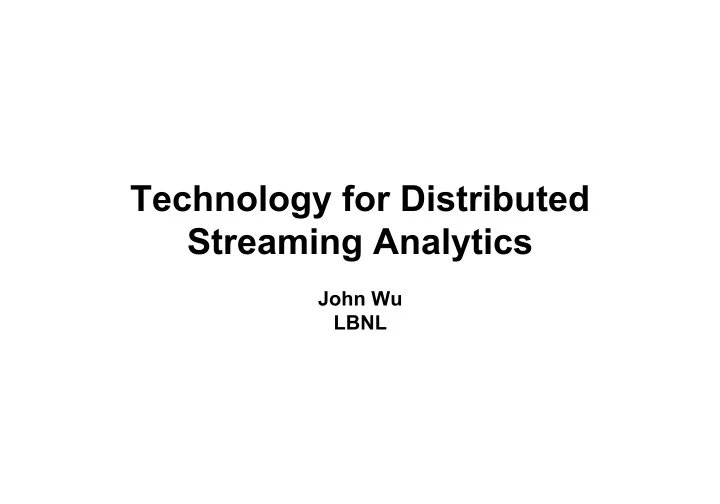

Technology for Distributed Streaming Analytics John Wu LBNL
Use Case 1: Near Real-Time Feature Detection Ø Fusion experiments are conducted at centralized facilities Ø Junior researchers often operate the devices, while senior researchers offer advices from afar Ø There are 10s of minutes between runs/shots Ø Need for distributed analysis Ø The experimental facility may not have enough computing power Ø Need to compare experimental measurements against simulation predictions Ø Measurement data ~GB/s, simulation data ~TB/s, need significant computing power for analysis Ø Distributed in transit processing Ø Make more processing power available Ø Allow more scientists to participate in the data analysis operations and monitor the experiment remotely Blobs in fusion reac/on Ø Enable scientists to share knowledge and Blob trajectory (Source: EPSI project) processes Wu, Sim, Choi, Churchill, Wu, Klasky, Chang, 2014 2
Use Case 2: Segmenting Microscopy Images J. Saltz, T. Kurc, M. Michalewicz, M. Parashar + ICEE team Challenge: identify cancerous cells in tissue image (120Kx120K) while the patient waits Partition slides Create low Query data into tiles resolution WAN (RDMA) data movement Stage high Segmentation Visualization resolution data and feature Technologies: (1) ICEE transport layer for wide-area, efficient transfers; (2) Longbow for very fast, low-latency connection; (3) pipelined processing on clusters Demo: Tissue slides on machine in Singapore. Analysis done on cluster at Georgia Tech. Segmentation results displayed on client machine. • Snapshot of adaptive processing of a remote slide • Image broken into pieces for parallel processing • Need to stitch the boundaries together 3
Use Case 3: Integrate Distributed Sensor Data from Power Grid • Sensors such as Phaser Measurement Units (PMU), Smart meters, thermostats, appliances create many data streams • Linked to other time and location-specific information (temperature, census, … ) • Proper analysis of such data is key to the vision of Smart Grid and Smart Cities 4
Technology Needed for Streaming Analytics Velocity Reduce data access latency, reduce volume transferred, move analysis § Volume Reduce the volume transferred, move analysis § Variety Enable multiple streams of data to be analyzed together § Veracity Understand the trade-offs for accuracy (of the query) vs. accuracy of the § results vs. performance (time to solution) Value Provide the freedom for scientists to access and analyze their data § interactively 5
Technology Example 1: Reduce Latency by Keeping Data in Memory Memory-to-memory data delivery (distributed code coupling) Transparent workflow execu/on ADIOS Analysis Data Stream FastBit Data Genera/on Index ADIOS Data Analysis Data Hub WAN Transporta/on Trans Compre FlexPath/EVPath • form ssion DataSpaces • ICEE • Analysis Utilizing ADIOS in situ processing capability to keep as much of the distributed workflow in memory as possible WAN transportation: FlexPath (GATech), DataSpaces (Rutgers), § ICEE (ORNL/LBNL) 6
Technology Example 2: Using Indexes to Locate Necessary data and Reduce Execution Time Remote file copy VS. index-and-query Measured between LBL and ORNL § Using indexes to locate necessary data, i.e., querying, reduces § overall execution time Naive Indexing File copy by using SCP Remote file copy Incremental 250M 250M 500M 1GB 4GB FastBit B B B Indexing 7
Technology Example 4: Grid Collector 1000 5 Sample 1 Sample 1 4 Sample 2 Sample 2 Sample 3 100 Sample 3 speedup speedup 3 2 10 1 1 0 0.00001 0.0001 0.001 0.01 0.1 1 0 0.2 0.4 0.6 0.8 1 selectivity selectivity ç more selective less selective à
Technology Example 4: Novel Data Reduction Based on Statistical Similarity ² Conventional compressions are based Original data on values, but the new technique is Volts based on Probability Density Function ² Theoretically, Locally Exchangeable Compressed data captures key variations Measures ² The method supports feature detection directly on the compressed data Compression ratio è 95 ² Test data: Micro PMU data from LBNL (original/compressed) ² Measured data compression ratio (original size in bytes / compressed size) reaches 95, using 64KB buffer ² Compared to gzip, LEM compressed data size is under 2% of gzip- compressed data size in bytes ² Locally Exchangeable Measures, U.S. Patent pending (serial no. 14/555,365) Contact: Alex Sim, SDM, CRD, LBNL <ASim@LBL.Gov>
Other Technologies Algorithms § Did not touch on algorithms for analysis, workflow orchestration, data integration, … Systems § Are existing systems sufficient? § What can be accomplished with the existing streaming systems? Networking needs Moving queries to the networking system § QOS: guarantee delivery (because data might not be saved § anywhere), guarantee bandwidth 10
Recommend
More recommend